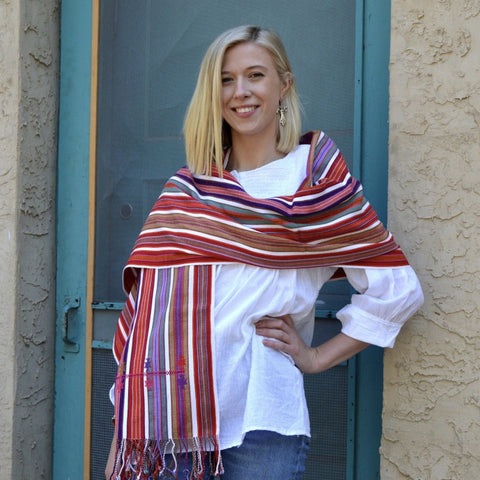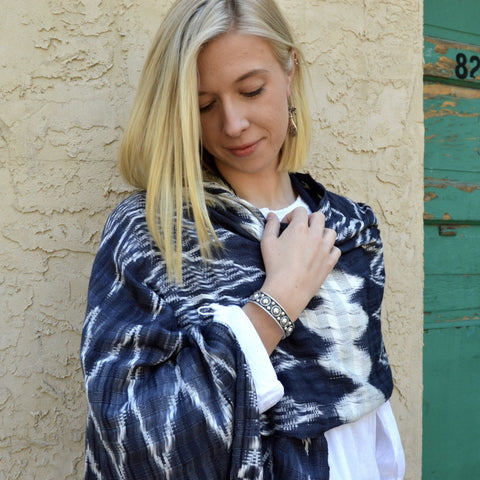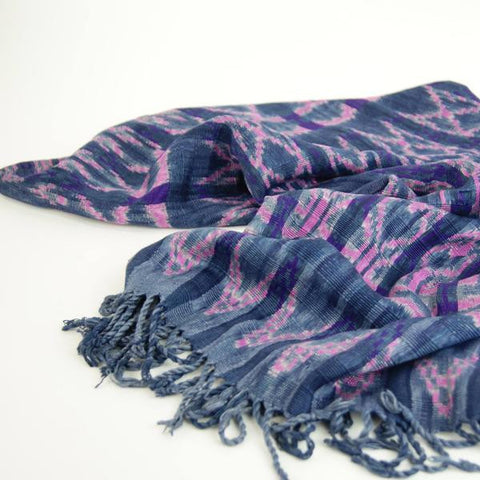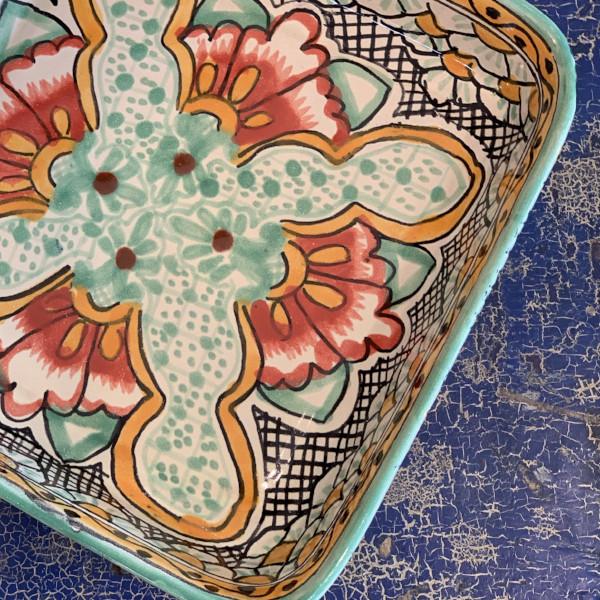The next topic in our Mexican Textile 101 series is the ubiquitous Mexican rebozo. A rebozo is a Mexican shawl, simultaneously elegantly simple and culturally significant. It is a quintessential Mexican staple, which evolved during the colonial period, and through time has been worn (and still is!) by all kinds of Mexican women, from indigenous women living in the mountains and valleys of Mexico to the most sophisticated business women and urban dwellers, from new mothers to elderly grandmothers to glamorous movie stars and heads of state. It is a garment mainly worn by women and is believed to enhance the grace of her movement while worn, as well as keep her warm in the place of a jacket or sweater. There are delicate rebozos of light-as-air silk for special occasions, such as Mexican Independence Day or a wedding, but there are also more durable workhorse rebozos, which are used to sling children onto one’s back, carry heavy loads, or even assist during childbirth!
A rebozo typically looks like a blend of a scarf and a shawl, and is usually a long, handwoven rectangle with hand-knotted fringe (called rapacejos), on both ends. Historically, rebozos have been woven with bright colors and patterns which make them identifiable by region. Other classic rebozos are dyed and woven using ikat techniques. A traditional rebozo is woven on a backstrap or upright loom, and can take thirty to sixty days to weave, and may be woven from cotton, wool, silk, or rayon; some are woven coarsely and are made for daily work, and others with a finer weave are so delicate that it is said that they can pass through a wedding ring. The choice of material used influences the price. Tenancingo has the largest number of rebozo producers, and is known for producing some of the highest quality, and there are also workshops in San Luis Potosi, La Piedad, Moroleon, and Uriangato, although sadly, some workshops that produced rebozos in the past have closed.
Although the use of traditional rebozos has waned a bit over time, there are people working to keep the tradition alive and some fashion houses have been working to bring them back. There is even a museum in Guadalajara devoted exclusively to the rebozo.
The rebozo is a Mexican woman’s flexible and indispensable accessory, and remains useful to her at every stage of her life. Rebozos are commonly worn in the countryside of Mexico throughout a woman’s life. It might carry her close to her mother when she is baby, and then another might be worn a certain way in her young adulthood, to indicate that she is available for courtship and marriage. A rebozo can be given in place of a wedding ring in some states. After marriage, it will be arranged in a different way around her torso to indicate that she is no longer single. The rebozo can lift her pregnant belly during childbirth, in order to reposition the baby during labor, and then later will carry her own baby close to her body after the child is born. Rebozos are worn on chilly days to add a little warmth. Some rebozos are 2 or 3 ply of thickness to keep women warm in the highlands of Chiapas and other mountainous states. A rebozo can serve women later in life, during a time when she must attend a funeral and grieve the loss of a loved one, and it even sometimes serves as a shroud for the dead.
If you don’t see yourself toting a baby close with one of our rebozos, or you have no weddings to attend this summer, but you still cannot resist the pull of this beautiful textile, some versions can also serve as lovely and bright table runners for a summer patio party!
Our current stock of rebozos can be found on our Textiles page or click on the photos to take you to the one featured.
If you're interested in other Mexican textiles, take a look at the first article in our series on Mexico Textiles about Saltillo Blankets!





